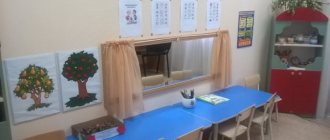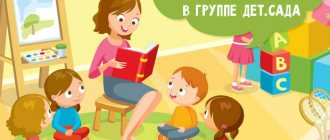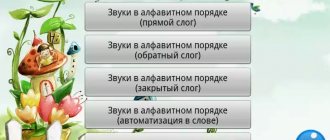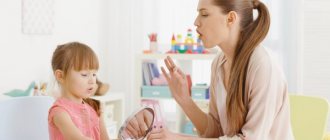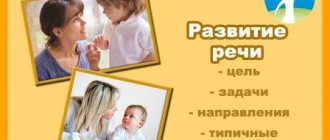I. Cabinet equipment:
- Wall mirror (at least 1.5 - 0.5 m).
- Children's table mirrors (9 x 12) according to the number of children.
- Children's tables and chairs for classes.
- Table for speech therapist.
- Two chairs for adults.
- Additional lighting at the mirror (table lamp).
- A table clock.
- Cabinets and shelves for methodological literature.
- Wall mounted school board.
- Typesetting canvas.
- Flannelograph.
- Clean towel.
- Card file for available benefits.
- Boxes or folders of the same size and color for storing manuals.
III. Documentation:
- Long-term plan for working with children for the year.
- Calendar plan for frontal, subgroup and individual classes.
- A speech card for each child with the necessary documentation: a) a referral from the speech therapist of the children's clinic to the medical-pedagogical commission; b) an extract from the medical history issued by the pediatrician of the clinic; c) certificates from an ENT specialist, an ophthalmologist, a neurologist, or a psychiatrist; d) characteristics for the child compiled by the teacher of the individual from whom the child comes. Make an entry in the speech card about the child’s progress at least once every 3 months.
- Notebooks for individual work with children.
- Schedule of speech therapy classes with children (timing of working hours for all days of the week).
- Long-term plan for preparing the classroom for the new academic year.
- Self-education plan for the current year.
Passport of the speech therapy office
Passport of the speech therapy room of the MBOU "Secondary School" No. ", Cheboksary (2020-2021 academic year)
Information about the speech therapy room
Short description
The office is small, located on the third floor of the Municipal Budgetary Educational Institution “Secondary School No.” in Cheboksary, in the right wing of the building.
Date of creation of the office 2006-2007 academic year.
The number of working speech therapists in the office is 1.
Total area – ___20_______ m2.
Illumination:
– type: mixed – natural and artificial
- sources: natural - window 1 pc., artificial - fluorescent lamps 4 pcs.
The office provides:
— 1 teacher’s workplace
— 6 workplaces for subgroup work
— 1 workplace for individual lessons
The walls are painted with water-based paint.
The floor is covered with linoleum.
The color of the walls, floors, and furniture was selected based on the principle of using calm and neutral tones that do not cause additional excitement or irritation.
The furniture in the office is installed in the context of the overall plastic composition.
Speech therapy office occupancy schedule
Monday 11.15 – 15.15 Friday 10.15 – 14.15
Tuesday 10.15 – 14.15
Wednesday 10.40 – 14.40
Thursday 10.55 – 14.55
Rules for using the speech therapy room
- keys to the office in two copies (one on duty, the second with the deputy director for administrative and chemical engineering)
— wet cleaning and washing of floors in the office is carried out daily;
— after each lesson the room is ventilated;
— at the end of the working day, check that windows are closed and electrical appliances are turned off.
The main purpose of the speech therapy room
— conducting a diagnostic examination of speech development of primary school students;
— conducting subgroup and individual classes of a speech therapist with children;
— advisory work of the speech therapist teacher with parents (conversations, open classes to demonstrate work techniques);
— advisory work of a speech therapist with teachers (familiarization of primary school teachers with the specifics and types of speech disorders that make it difficult for students to successfully master reading and writing).
The office space should be organized in accordance with the specific activities of the speech therapist teacher. The criteria by which a specialist’s workspace is organized:
— Scientific character – providing a methodological basis for a specialist’s activities, compliance with qualification and methodological requirements. — Health preservation – compliance with regulatory requirements of SanPiN; satisfaction of students’ motor activity; providing the opportunity to conduct classes of various forms - games, classes with movements, classes with changing static postures, etc.
Work areas
— Speech therapist's work area
(TCO zone) is a desktop with retractable drawers. The desk drawers contain the speech therapist's documents and a file cabinet with information about children and parents. The attendance register, computer, printer, and projector are stored on the table.
The work area is used for preparing for work (classes, consultations, etc.), processing data, storing survey materials, working documentation, methodological literature, manuals, etc.
— The area
of didactic and methodological support
is represented by a cabinet for storing educational material: speech therapist documentation; diagnostic material; systematized didactic material; literacy aids; literature on overcoming general speech underdevelopment; gaming software (toys, board games, educational cards).
— Sound pronunciation correction zone
equipped with a wall mirror (50×100), individual mirrors (6 pieces), a table; a set of cards for articulation gymnastics, a card index with games; disposable spatulas, probes, aids for correcting sound pronunciation.
— Correction and development zone
equipped with a set of 3 double desks, 6 chairs; magnetic board; with a pointer, a ribbon of letters hangs above the board, on the left is a poster “Phonetic analysis of the word”, on the right is “Alphabet. Printed and handwritten letters."
Sensorimotor area
equipped with material for the development of fine motor skills. Aids for the development of fine and gross motor skills: mosaics, counting sticks, beads, puzzles, neuro-skipping rope.
—
Areas for the use of health-saving technologies
Equipment for the development of sensations of movement of the respiratory organs, speech exhalation, and a strong air stream. Breathing exercise attributes: “Snowflake”, “Cloud”, “Butterflies”, “Birds”.
Benefits
for vision development: 1) moving objects; 2) visual simulators; 3) sets of exercises based on verbal instructions.
Sujok therapy. Using massage balls of different diameters
.
Speech therapy room equipment
Documentation
| № p/p | Name |
| 1 | Regulatory framework. Laws of the Russian Federation. |
| 2 | Regulations and documents regulating the work of the speech therapy room of the educational institution. Functional responsibilities of a speech therapist at an educational institution. |
| 3 | Passport of the speech therapy office. |
| 4 | Logbook of attendance at speech therapy classes. |
| 5 | Register of children in need of speech therapy help. |
| 6 | Speech cards. |
| 7 | List of students enrolled in correctional speech therapy classes. |
| 8 | Lists of students by speech therapy groups. |
| 9 | Speech therapist annual plan. |
| 10 | Work program for individual work on sound production. |
| 11 | Programs of correctional and developmental work. |
| 12 | Speech therapy support programs for disabled children. |
| 13 | Speech therapist teacher's work schedule. |
| 14 | Analysis of speech therapy work for the academic year. Digital report. |
| 15 | Journal of speech therapist consultations. |
LIST OF FURNITURE
| No. | Name | Quantity | Inv No. | Note |
| 1 | Desk | 1 | ||
| 2 | Student desk | 3 | ||
| 3 | Wall mounted school board | 1 | ||
| 4 | Book shelf | 1 | ||
| 5 | Chair | 6 | ||
| 6 | Armchair | 1 | ||
| 7 | Shelves for flowers | 3 |
MATERIAL VALUES
| No. | Name | Quantity | Inv No. | Note |
| 1 | Computer | 1 | ||
| 2 | Monitor | 1 | ||
| 3 | Tulle curtain | 1 | ||
| 4 | Cornice | 1 | personal | |
| 7 | Heater | 1 | personal | |
| 9 | Wall mirror | 1 | ||
| 10 | Children's table mirrors | 5 | ||
| 13 | Boxes and folders for manuals |
CATALOG OF EDUCATIONAL AND METHODOLOGICAL LITERATURE
| No. | Name | Author | The year of publishing |
| 1 | Speech therapy at school | Edited by V.S. Kukushina. | 2007 |
| 2 | Organization of speech therapy work at school. | Eletskaya O.V., Gorbachevskaya N.Yu. | 1991 |
| 3 | Speech therapy | Zhukova N.S., Mastyukova E.M. Filicheva T.B. | 1995 |
| 4 | Correction of oral and written speech for primary school students | Efimenkova L.N. | 2001 |
| 5 | Speech therapist's reference book. | M.A. Povalyaeva | 1998 |
| 6 | Software and methodological materials for speech therapy classes with primary schoolchildren. | L.M. Kozyreva | 2006 |
| 7 | Dysgraphia, dyslexia: technology of overcoming. | I.N. Sadovnikova | 2001 |
| 8 | Speech therapy support for primary school students. Letter. Software and methodological materials. | O.A. Ishimova, S.N. Shakhovskaya, A.A. Almazova | 2014 |
| 9 | Speech therapy album for the correction of writing disorders in schoolchildren in grades 3-5. | T. I Prokopyeva | 2007 |
| 10 | A magical world of sounds and words. | E.A. Pozhilenko | 2011 |
| 11 | Correction of acoustic dysgraphia | E.V. Mazanova | 2011 |
| 12 | Correction of dysgraphia due to impaired language analysis and synthesis. | E.V. Mazanova | 2011 |
| 13 | Correction of agrammatic dysgraphia. | E.V. Mazanova | 2007 |
| 14 | Corrective speech therapy work with schoolchildren with mental retardation. | P.D. Lebedeva | 2007 |
| 15 | Methods for developing independent written speech in children. | E.N. Russian | 2007 |
| 16 | Methodology for the development of coherent speech in children with systemic speech underdevelopment. | VC. Vorobyova | 2007 |
| 17 | Speech development. Letter. | O.A. Ishimova, A.A. Almazova | 2007 |
| 18 | Speech therapy album for the correction of writing and reading disorders in primary schoolchildren. | T.I. Prokopieva | 2013 |
| 19 | Secrets of prepositions and cases. | E.V. Novikova | 2007 |
| 20 | Practical material for classes on speech development of children with special needs development. | L.G. Kobzareva, M.P. Rezunova, G.N. Yushina | 2008 |
| 21 | Games and exercises for speech development at the 1st stage of remedial education for children with special needs development. | L.G. Kobzareva, M.P. Rezunova | |
| 22 | Correction of written speech disorders in junior high school students. | O.M. Kovalenko | 2006 |
| 23 | How words are formed. | L.M. Kozyreva | 2006 |
| 24 | Speech therapy. Overcoming writing impairment. | E.V. Mazanova | 2005 |
| 25 | Dysgraphia. Language analysis and synthesis. 3rd grade | M.V. Malm, O.V. Suslova. | 2017 |
| 26 | Dysgraphia. Language analysis and synthesis. 2nd grade | M.V. Malm, O.V. Suslova. | 2017 |
| 27 | PREVENTION AND CORRECTION OF WRITTEN SPEECH DISORDERS IN CHILDREN. Unstressed vowels at the root of the word. | V.V. Konovalenko, S.V. Konovalenko, M.I. Kremenetskaya | 2012 |
| 28 | Teach me to speak correctly. | O.I. Krupenchuk | 2003 |
| 29 | Development of verbal-logical thinking in coherent speech. Assignments and exercises. | L.V. Zubareva | 2011 |
| 30 | Speech therapy. Agrammatic form of dysgraphia. | E.V. Mazanova | 2009 |
| 31 | Speech therapy. Dysgraphia caused by a violation of language analysis and synthesis and agrammatic dysgraphia. | E.V. Mazanova. | 1997 |
| 32 | Words are friends and words are enemies | L.M. Kozyreva | 2006 |
| 33 | Methodological recommendations for creating the sounds s, sh, r, l in children. | E.A. Pozhilenko | 2006 |
| 34 | Correcting the pronunciation. A comprehensive technique for correcting articulation disorders. | O.I. Krupenchuk, T.A. Vorobyova | 2007 |
| 35 | Correction of stuttering in primary schoolchildren. | E.N. Maslova | 2011 |
| 36 | Learn to speak correctly. | A.S. Mayorova | 2003 |
| 37 | Diagnosis of speech disorders in schoolchildren using neuropsychological methods. | Fotekova T.A. | 2007 |
| 38 | Speech therapy | J.M. Flerova | 2004 |
| 39 | Paired voiced-voiceless consonants D-T. | V.V. Konovalenko, S.V. Konovalenko | 2013 |
| 40 | Paired voiced-voiceless consonants Zh-Sh. | V.V. Konovalenko, S.V. Konovalenko | 2013 |
| 41 | Paired voiced-voiceless consonants G-K. | V.V. Konovalenko, S.V. Konovalenko | 2013 |
| 42 | Paired voiced-voiceless consonants B-P. | V.V. Konovalenko, S.V. Konovalenko | 2013 |
| 43 | Paired voiced-voiceless consonants V-F. | V.V. Konovalenko, S.V. Konovalenko | 2013 |
| 44 | Paired voiced-voiceless consonants Z-S.. | V.V. Konovalenko, S.V. Konovalenko | 2013 |
| 45 | Consonants and vowels are similar, but different | O.V. Epifanova | 2006 |
| 46 | Synonyms | V.V. Konovalenko, S.V. Konovalenko | 2012 |
| 47 | Antonyms | V.V. Konovalenko. S.V. Konovalenko | 2011 |
| 48 | Explanatory dictionary of the Russian language. Modern version for schoolchildren. | IN AND. Dahl | 2010 |
| 49 | Testing of children. | V. Bogomolov | 2005 |
| 50 | Violation of the voice and sound-pronunciation side of speech. Part 1: Voice disorder. Dislalia. | S.N. Shakhovskaya, T.V. Volosovets, O.S. Orlova, L.G. Paramonova. | 2003 |
| 51 | Violation of the voice and sound-pronunciation side of speech. Part 2: Rhinolalia. Dysarthria. | S.N. Shakhovskaya, T.V. Volosovets, L.G. Paramonova. | 2003 |
| 52 | Basics of speech therapy with sound pronunciation workshop | T.V. Volosovets | 2002 |
| 53 | Vocabulary development in children. | L.G. Paramonova | 2010 |
| 54 | Distinguishing sounds and letters | O.S. Alekseeva | 2017 |
Didactic materials and manuals for speech therapy classes
BENEFITS
1. For examination:
1). Pronunciations.
2) Phonetic perception, phonemic analysis and synthesis, phonemic representations.
3) The syllabic structure of the word.
- Dictionary.
- The grammatical structure of speech.
- Independent speech.
- Written speech, language analysis.
- Counting material.
- Cut pictures from 2-4-6 parts.
- Pictures and texts with hidden meaning.
- Articulation exercises (cards).
6. Sound profiles.
- A set of aids for working on speech breathing.
- Subject pictures for all studied sounds.
- Albums for automation of delivered sounds.
- Texts for automation of delivered sounds.
- Games.
- Formation of phonetic perception, sound analysis:
- Signal circles for differentiating sounds.
- Object pictures for differentiation of sounds.
- Texts on sound differentiation.
- Symbols of sounds.
Certificate
- ABC in pictures.
- Schemes for analyzing proposals.
- Sets of subject pictures for dividing words into syllables.
- Speech therapy lotto.
- Noun. Sets of subject pictures.
- Verb. Sets of subject pictures.
- Adjective. Sets of subject pictures.
- Adverb. Sets of subject pictures.
- Numeral. Sets of subject pictures.
WORK ON THE DICTIONARY
1. Subject pictures:
— Vegetables — Berries
- Birds - Family - Plants - Mushrooms - Clothes - Dishes - Toys - Insects - Professions - Trees - Fruits - Animals and their babies - Transport - Tools - School supplies 2. Subject pictures for the selection of antonyms. 3. Subject pictures for the selection of synonyms.
GRAMMATICAL STRUCTURE OF SPEECH
- Preposition schemes.
- Guides to writing sentences with simple and complex prepositions.
- Benefits for approval.
- Deformed texts.
DEVELOPMENT OF CONNECTED SPEECH.
- Series of plot pictures.
- Scene pictures.
- Sets of subject pictures for compiling comparative and descriptive stories.
Computer presentations
| № p/p | Presentation name |
| 1 | Let's learn to speak correctly. |
| 2 | Grammar and writing. |
| 3 | Reading Basics. |
| 4 | Reading. |
| 5 | Basics of grammar and writing. |
| 6 | We learn letters and words. |
